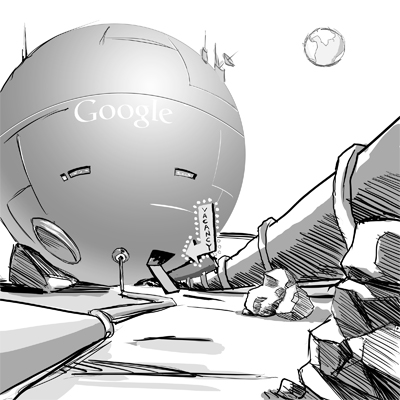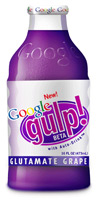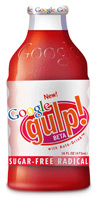Google is not only famous for it's search or ads it ahs also been famous for one more stuff. It's the Fool's day Pranks. It is known to play prank it's user on April 1. Sice 2000 they have been doing this expect 2001 and 2003. Some of them really look convincing.
2000: Google MentalPlex

In the year 2000 Google announced a new search technology called "MentalPlex" . It supposedly read the user's mind to determine what the user wanted to search for, thus eliminating the step of actually typing in the search query. All that the user had to do was remove his Hat and Glasses and stare at the above image. It said that it worked for all languages.
There was even a elaborate FAQ page. It even gave some troubleshooting tips
Problem: MentalPlex keeps taking me to sites featuring rubber toys, nipples and diapering.
Answer: Your infant is too close to the monitor. If you have no children, you may want to consider counseling.
Problem: I am unable to visualize clicking and have to use my finger to activate the mouse.
Answer: Click visualization takes practice. Try pushing the mouse button with your eyebrow, then gradually increase the distance between your eye and the mouse.
They even gave illustrations as in to how to go about
~~~~~~~~~~~~~~~~~~


~~~~~~~~~~~~~~~~~~~~~~~~~~~~~~~
First two was said to be the wrong way to do it as the user had wore hat and glasses in the first one and in the second one he didn't stare at the monitor.
Try out Google Mentalplex
2002: Pigeon Rank

Google claimed reveals the technology behind its Search System . They called it PigeonRank actual name of their technology was Page Rank.
They said Larry Page and Sergey Brin,the Google founders developed this technology at Satndford university based on breakthrough work of B. F. Skinner(probably a scientist). Google touts the benefits of this cost-effective and efficient means of ranking pages and reassures readers that there is no animal cruelty involved in the process.

The article makes many humorous references and puns based on computer terminology and how Google PageRank really works.They even mentioned that that the birds were kept in good condition and where fed the best food. They even offered newsletter for readers to know more on their technology " Google Friends newsletter. "
View the actual page
2004: Google Lunar/Copernicus Center

Google claims to give Jobs to 35 engineers at their Googlunaplex. It is GooglePlex in Moon i.e you work at Google office located at moon. It claimed to contain 27,000 low cost web servers, 2 massage therapists and a sushi chef formerly employed by the pop group Hanson.

It was called G-CHEESE (Google Copernicus Hosting Environment and Experiment in Search Engineering) Google's initial base, a spherical structure containing living quarters and a small data center, will take two and a half years to construct. first G.C.H.E.E.S.E ball has been christened the Googlunaplex.
Google also said that they would release version 10.0 of an operating system that has been optimized for the demands of extra-terrestrial computation. Known as Luna/X, the new command architecture i was said to be impervious to radiation, low gravity, absolute zero temperatures and airless environments.
Those interested had to contact Google at lunarjobs@google.com. They had to be at least 18 years of age by April 1, 2007 and have proof of earth residency.
Work at Google Lunar
2005: Google Gulp

Google Gulp, a fictitious drink, was announced by Google in 2005. They claimed that this was develiped by one of their employee VP of operations Urs Hoelzle . He used to collect floral plants from tropical rain forest in his 20% time. They said that the Flowers contained nothing special – bag of future steroids, muscle relaxants, long-shot cancer drugs. But one day the flowers contained a special chemical.That led to creation of this juice/drink.
According to the company, this beverage would optimize one's use of the Google search engine by increasing the drinker's intelligence. It was claimed this boost was achieved through real-time analysis of the user's DNA and carefully tailored adjustments to neurotransmitters in the brain (a patented technology termed Auto-Drink).
The drink was said to come in "4 great flavors": Glutamate Grape (glutamic acid), Sugar-Free Radical (free radicals), Beta Carroty (beta carotene), and Sero-Tonic Water (serotonin).



This hoax was likely intended as a parody of Google's invite-only email service called Gmail. Although ostensibly free, the company claimed the beverage could only be obtained by returning the cap of a Google Gulp bottle to a local grocery store: a causal loop. In the Google Gulp FAQ, Google replies to the observation "I mean, isn't this whole invite-only thing kind of bogus?" by saying "Dude, it's like you've never even heard of viral marketing."
Take a sip
2006: Google Romance
On April Fool's Day 2006, Google Romance was announced on the main Google search page with the introduction, "Dating is a search problem. Solve it with Google Romance." It pretends to offer a "Soulmate Search" to send users on a "Contextual Date". A parody of online dating, it amusingly had a link for "those who generally favor the 'throw enough stuff at the wall' approach to online dating" to Post multiple profiles with a bulk upload file, you sleaze in addition to Post your Google Romance profile. Clicking on either of these gave an error page, which explained that it was an April Fool's joke and included links to previous April Fool's Jokes for nostalgia.
Find a Google Date
2007: Gmail Paper & Google TiSP
Gmail Paper
At about 10:00 PM Pacific time (where Google has its headquarters) the day before April 1, 2007, Google changed the login page for Gmail to announce a new service called Gmail Paper. The service offered to allow users of Google's free webmail service to add e-mails to a "Paper Archive," which Google would print (on "96% post-consumer organic soybean sputum") and mail via traditional post. The service would be free, supported by bold, red advertisements printed on the back of the printed messages. Image attachments would also be printed on high-quality glossy paper and be postmarked with their message, though MP3 and WAV files would not be printed.
The page detailing more information about the service features photographs of Ian Spiro and Carrie Kemper, current employees of Google. Also featured are Product Marketing Managers of Gmail Anna-Christina Douglas, and Kevin Systrom.
Google TiSP

Google TiSP (short for Toilet Internet Service Provider) was a fictitious free broadband service supposedly released by Google. This service would make use of a standard toilet and sewage lines to provide free Internet connectivity at a speed of 8 Mbit/s (2 Mbit/s Upload) (or up to 32 Mbit/s with a paid plan). A user drops a weighted end of a long, Google-supplied fiber-optic cable in their toilet and flushes it. Around 60 minutes later, the end would be recovered and connected to the Internet by a "Plumbing Hardware Dispatcher (PHD)." The user then connects their end to a Google-supplied wireless router and run the Google-supplied installation media on a Windows XP or Vista computer ("Mac and Linux support coming soon").
Alternatively, a user could request a professional installation, where Google would deploy nanobots through the plumbing to complete the process. The free service would be supported by "discreet DNA sequencing" of "personal bodily output" to display online ads that relate to culinary preferences and personal health. Google also references the Diet Coke and Mentos reaction in their FAQ, "If you're still experiencing problems, drop eight mints into the bowl and add a two-liter bottle of diet soda."
Non-hoaxes
Google has also anounced some of their actual products on Fools day. On April Fool's Day 2004 (or rather, very shortly before midnight on March 31), Google announced the launch of Gmail, making some believe it was a hoax as web-based e-mail with one gigabyte of storage was unheard of at the time but later turned out to be real. This marketing strategy is used to make people think that the product is a hoax and then to surprise them .


0 comments:
Post a Comment